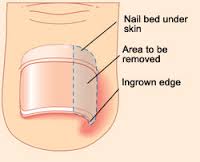Ingrown toenails, also known as onychocryptosis , describes a very a painful condition of the foot. It occurs when a sharp corner of the toenail digs into the skin at the end of or side of the toe. Pain and inflammation at the spot where the nail curls into the skin occurs first. Later, the inflamed area can begin to grow extra tissue or drain yellowish fluid.
For most ingrown toenails, problems can be prevented with proper grooming of the toes and by wearing better-fitting shoes. Try to reduce pressure on the toe by wearing sandals or by not wearing a shoe for several days.
The most common signs and symptoms of Ingrown Toenails are pain, redness, and swelling at the corner of a toenail.
- Early in the course of an ingrown toenail, the end of the toe becomes reddened and painful with mild swelling. There is no pus or drainage. It may feel warm to the touch, but you will not have a fever.
- Later, extra skin and tissue will grow around the sharp point of the nail. A yellowish drainage may begin. This is the body’s response to the trauma of a nail irritating the skin. And is not necessarily an infection.
- Sometimes an infection develops. In this case, the swelling will become worse, and there may be white- or yellow-colored drainage (pus) from the area. A lighter-colored area of the skin may be surrounded by red skin. You may develop a fever, although this is unusual.
If you notice an infection, see your doctor, who may prescribe an antibiotic. In many cases, your doctor may recommend partial removal, of a severely ingrown nail. Unless the ingrowing piece of nail is removed, the problem will often persist. Permanent removal of the nail root at the ingrown side may be advised if ingrown nails recur. These procedures are done in the doctor’s office or surgery center under a local anesthetic. Sometimes an ingrown nail is caused by a fungus. A doctor can determine if you have a fungus and then offer treatment option
If a person decides to attempt treatments at home, over-the-counter pain medications, such as ibuprofen, may help with the discomfort as well as the inflammation, caused by the ingrown toenail. If there has been no progress after three days of home treatment or if fluids start to ooze from the toe, a doctor should be consulted for further evaluation. Many people prefer that ingrown toenail treatments be administered by a doctor, even if there are no complications.



